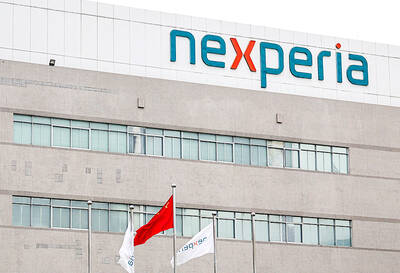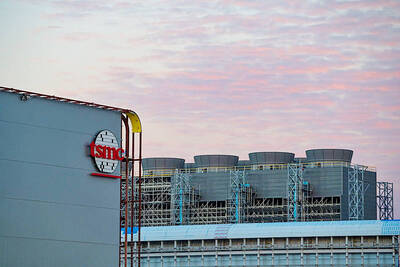US President Donald Trump’s administration is sketching out tougher versions of US semiconductor curbs and pressuring key allies to escalate their restrictions on China’s chip industry, an early indication the new US president plans to expand efforts that began under former US president Joe Biden to limit Beijing’s technological prowess.
Trump officials recently met with their Japanese and Dutch counterparts about restricting Tokyo Electron Ltd and ASML Holding NV engineers from maintaining semiconductor gear in China, people familiar with the matter said.
The aim, which was also a priority for Biden, is to see key allies match China curbs the US has placed on US chip gear companies, including Lam Research Corp, KLA Corp and Applied Materials Inc.

Photo: Reuters
In Beijing, the Chinese Ministry of Foreign Affairs yesterday said that the US plan of coercing other countries into going after China’s semiconductor industry would backfire.
Such actions by the US would hinder development of the global semiconductor industry, ministry spokesman Lin Jian (林劍) told a regular press briefing.
The Trump team’s meetings come in addition to early discussions in Washington about sanctions on specific Chinese companies, other people said.
Some Trump officials also aim to further restrict the type of Nvidia Corp chips that can be exported to China without a license.
They are also having early conversations about tightening existing curbs on the quantity of artificial intelligence (AI) chips that can be exported globally without a license, some of the people said.
It could take months before the talks produce any new US regulations, as Trump makes staffing decisions at key federal agencies. It also remains to be seen whether allies would be more receptive to the new leadership in Washington.
Some officials on the US National Security Council are considering blocking Chinese memory chipmaker ChangXin Memory Technologies Inc (長鑫存儲) from buying US technology, while others also want to intensify restrictions on Semiconductor Manufacturing International Corp (中芯國際), the main chipmaking partner of Chinese telecom giant Huawei Technologies Co (華為).
Then there is the so-called AI diffusion rule, imposed in the final week of Biden’s term. The measure divided the world into three tiers of countries and set maximum thresholds for the AI computing power that can be shipped to each. It also established mechanisms for companies to validate the security of their projects and access higher compute limits.
The rule, which would impact data center developments everywhere from Southeast Asia to the Middle East, drew harsh rebuke from companies including Nvidia. The White House is discussing how to streamline and strengthen that framework, several people familiar with the conversations said, although what that entails is still in flux.
One idea favored by some in the administration would be to reduce the computing power that can be exported without a license. Under current restrictions, chipmakers only have to notify the government before exporting the equivalent of as many as 1,700 graphic processing units (GPUs) to most countries.
Some Trump officials want to reduce that threshold, people familiar with the matter said, which would expand the scope of the license requirement.
Additional reporting by Reuters

JITTERS: Nexperia has a 20 percent market share for chips powering simpler features such as window controls, and changing supply chains could take years European carmakers are looking into ways to scratch components made with parts from China, spooked by deepening geopolitical spats playing out through chipmaker Nexperia BV and Beijing’s export controls on rare earths. To protect operations from trade ructions, several automakers are pushing major suppliers to find permanent alternatives to Chinese semiconductors, people familiar with the matter said. The industry is considering broader changes to its supply chain to adapt to shifting geopolitics, Europe’s main suppliers lobby CLEPA head Matthias Zink said. “We had some indications already — questions like: ‘How can you supply me without this dependency on China?’” Zink, who also

The number of Taiwanese working in the US rose to a record high of 137,000 last year, driven largely by Taiwan Semiconductor Manufacturing Co’s (TSMC, 台積電) rapid overseas expansion, according to government data released yesterday. A total of 666,000 Taiwanese nationals were employed abroad last year, an increase of 45,000 from 2023 and the highest level since the COVID-19 pandemic, data from the Directorate-General of Budget, Accounting and Statistics (DGBAS) showed. Overseas employment had steadily increased between 2009 and 2019, peaking at 739,000, before plunging to 319,000 in 2021 amid US-China trade tensions, global supply chain shifts, reshoring by Taiwanese companies and

Taiwan Semiconductor Manufacturing Co (TSMC, 台積電) received about NT$147 billion (US$4.71 billion) in subsidies from the US, Japanese, German and Chinese governments over the past two years for its global expansion. Financial data compiled by the world’s largest contract chipmaker showed the company secured NT$4.77 billion in subsidies from the governments in the third quarter, bringing the total for the first three quarters of the year to about NT$71.9 billion. Along with the NT$75.16 billion in financial aid TSMC received last year, the chipmaker obtained NT$147 billion in subsidies in almost two years, the data showed. The subsidies received by its subsidiaries —

Shiina Ito has had fewer Chinese customers at her Tokyo jewelry shop since Beijing issued a travel warning in the wake of a diplomatic spat, but she said she was not concerned. A souring of Tokyo-Beijing relations this month, following remarks by Japanese Prime Minister Sanae Takaichi about Taiwan, has fueled concerns about the impact on the ritzy boutiques, noodle joints and hotels where holidaymakers spend their cash. However, businesses in Tokyo largely shrugged off any anxiety. “Since there are fewer Chinese customers, it’s become a bit easier for Japanese shoppers to visit, so our sales haven’t really dropped,” Ito